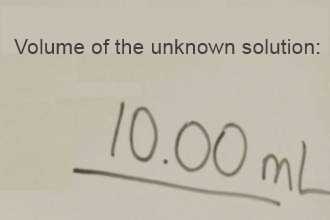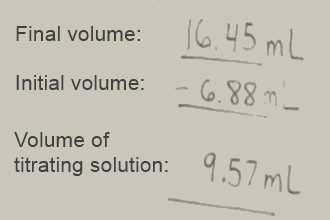The art of titration
Titration of an unknown HCl solution by par NaOH 0,1 M in the presence of phenolphtalein indicator
Use ← and →

The burette is washed with distilled water.
The burette is washed with the titrating solution.
The titrating solution is evacuated.
The burette is fixed onto the stand.
En Erlenmeyer flask is put in place.
The tap is shut.
A funnel is put in place.
The burette is filled to 3/4 with the titrating solution.
Air bubbles are elimiated by tapping the burette.
The funnel is taken of.
Some titrating solution is drained off in order to elimiate bubbles in the tap.
The Erlenmeyer flask is emptied.
The Erlenmeyer is washed with some distilled water.
The initial volume is identified (the lowest point of the meniscus).
The initial volume is noted.
A wellknown volume of the unknown solution is taken with a pipette which was washed beforehand by the same solution.
The unknown solution is introduced to the Erlenmeyer without blowing in the pipette.
A few drops of indicator are also introduced.
The volume of the unknown solution is noted .
A sheet of white paper is placed under the Erlenmeyer in order to see the color change.
Titration is executed with one hand, the other hand serves to shake the Erlenmeyer flask.
A first rapid titration is executed to determine the equivalence point approximately.
The next titrations are executed to one drop accuracy (left OK, right not OK).
The final volume in the burette is measured .
The correct final volume of titrating solution is found by averaging the measures of the last accurate titrations (3 preferably).

























The burette is washed with distilled water.

Adapted from video by Carolina

































